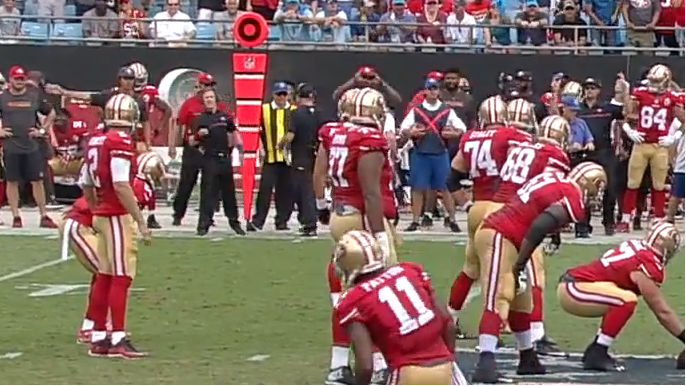(Screengrab via Fox)
SANTA CLARA — One of the more interesting details to emerge out of the 49ers’ Week 2 loss to the Panthers was the pacing of Chip Kelly’s offense.
When the 49ers slowed it down in the second quarter, they produced their best drive of the game, a 59-yarder that culminated in a Torrey Smith touchdown reception.
In fact, four of the seven plays during that drive de-emphasized a hurry-up pace. Blaine Gabbert still used the no-huddle to quickly line up his offense, but then pulled away to look towards the sidelines. SB Nation’s Jennifer Lee Chan dubbed it the Meerkat offense.
The advantage here is clear. Chip Kelly can give Gabbert instructions after looking at Carolina’s defensive front. It’s a college concept Kelly has brought with him to the NFL and it worked for the 49ers against one of the better defenses in the league. Interesting to note, all four of those Meerkat plays were rushes — an 8-yard run from Carlos Hyde and an 18-yard burst from Shaun Draughn setup the eventual touchdown pass from Gabbert.
“It’s a good mixup to have,” quarterback Christian Ponder told KNBR.com in the locker room Tuesday. “It gets the defense to undress what they are doing. It’s something we keep in our back pocket to keep defenses honest. We make sure we’re getting the look we want on certain plays. And you can kind of figure out what the defense is doing.”
The 49ers practice this concept during the week with hand-signals on the sidelines. But Ponder said using the Meerkat does not necessarily mean Kelly is giving Gabbert an audible. It’s just an extra line of communication to have. Ponder said all the over-communication actually helps the quarterback pre-snap, not overwhelm him.
Offensive coordinator Curtis Modkins gave some more clarification of the Meerkat offense, too. When the 49ers slow the pace like this, it’s not an on-the-fly in-game adjustment, rather a planned option on the play-call.
“The thing about how we operate is, whatever the pace is, we control it,” Modkins said. “So, if we decide to go really fast, it’s on us. If we decide to slow it down, it’s on us. So, the tempo in this offense, whatever it is, we control it.”
The lone downside to this Meerkat offense is that you let the defense catch their breaths. The whole point of the hurry-up is to simultaneously put opponents in the wrong personnel groupings, while also wearing them down throughout the course of the game. The Meerkat only accomplishes one of these strategies. And for this reason, it’s not really feasible to use over the entire course of a game.
“The problem is defenses start picking up on (the Meerkat),” Ponder said. “And then they start making their own calls from the sideline. It’s like a chess game between the offense and defense.”
The 49ers didn’t use the Meerkat once in the second half. Two turnovers turned into two short touchdown drives in the fourth quarter, but the offense struggled to move the football without Kelly’s sideline adjustments.
It’s too early to say Kelly’s offense is better in San Francisco when the pace is slower. He won’t want to change his core football philosophy. But that second quarter drive was successful because of the Meerkat. And if the 49ers run into trouble against Seattle, they should lean back on the concept.


